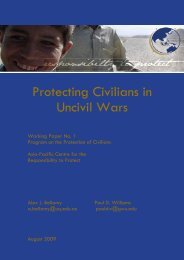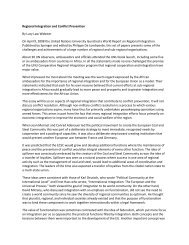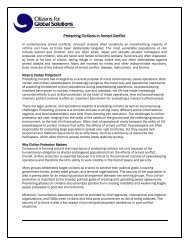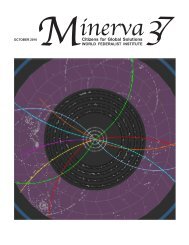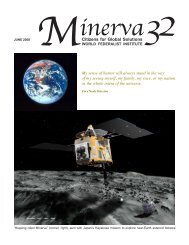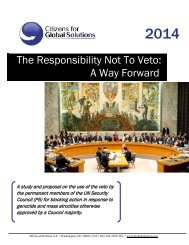Minerva, Fall 2011 - Citizens for Global Solutions
Minerva, Fall 2011 - Citizens for Global Solutions
Minerva, Fall 2011 - Citizens for Global Solutions
- No tags were found...
Create successful ePaper yourself
Turn your PDF publications into a flip-book with our unique Google optimized e-Paper software.
and <strong>for</strong>mer Secretary of State HenryKissinger <strong>for</strong> proposing abolition, twentyyears later Nunn and Kissinger joined <strong>for</strong>merSecretary of Defense William Perryand <strong>for</strong>mer Secretary of State GeorgeShultz in adopting Reagan’s ideas. TheFour Horsemen of the Non-Apocalypse,in their justly famous Wall Street Journaleditorial of January 4, 2007, boldly called<strong>for</strong> “a world free of nuclear weapons.”Having looked <strong>for</strong> decades at the variousdead-ends to which nuclear weaponsled, and the “increasingly hazardous”and “more precarious” nuclear future inwhich (a) even unpredictable third worlddictators were now capable of acquiringnuclear weapons and (b) nuclear materialscould more easily fall into the handsof non-deterrable terrorists, they endorsedReagan and Gorbachev’s vision of a nuclearfree world. 1 Similarly, dozens ofstatesmen from all over the world havecome out <strong>for</strong> abolition, as have dozens ofretired military generals and admirals andthe like (just to name a few: Admiral NoelGaylor, Admiral Eugene Carroll, GeneralLee Butler, General Andrew Goodpaster,General Charles Horner, George Kennan,Melvin Laird, Robert McNamara,Colin Powell, and George H.W. Bush). 2In short, the idea of abolishing nuclearweapons has moved from being the viewof a prophetic few 3 to being the new consensusposition, 4 held by approximately80% of the American public. 5And yet, despite this shift of both eliteand public opinion, twenty years afterthe supposed end of the Cold War, westill have thousands of nuclear missilesready to go off in minutes, with a collective<strong>for</strong>ce 150,000 times the power of theHiroshima bomb. With “a decision window<strong>for</strong> each country’s president of fourto eight minutes” (after deducting time<strong>for</strong> missile attack detection and confirmation,and the time <strong>for</strong> the response launchsequence and fly-away), 6 the increasinglydecrepit Russian C-3 (command,control, communications) systems, anda long history (largely unknown to theAmerican public) of “near misses” withnuclear war, 7 it is no wonder that those inthe know have become disenchanted withour current strategic posture. As one veryknowledgeable nuclear weapons industryinsider puts it:It has always been acknowledged thatan international security system basedon the willingness of nations to commitmutual suicide in order to protectthemselves is a suboptimum solutionto the security dilemma. 8Suboptimal indeed. George Shultz summedup the situation about as concisely asanyone when, confronted by the neoconservativesabout what almost transpired atReykjavik, he responded simply: “What’sso great about a world that can be blownup in 30 minutes?” 9In short, we find ourselves in a paradoxicalsituation where both candidates <strong>for</strong>president in 2008 ran on a plat<strong>for</strong>m ofabolishing nuclear weapons, where weare already theoretically obligated toeliminate them pursuant to the 1968 Non-Proliferation Treaty (Article VI), and yet,<strong>for</strong> whatever reason — bureaucratic inertiaor the machinations of the militaryindustrial-congressionalcomplex — wehave thousands of nuclear weapons stillready and waiting to more or less end theworld in the course of one rather long afternoon.10 Despite all this, however, thereis a growing sense, a building momentum,a feeling that now is the time <strong>for</strong> abolition.The books under review all reflectthis consensus.46 • <strong>Minerva</strong> #39 • November <strong>2011</strong>Two basic arguments are being made <strong>for</strong>abolition: (1) that nuclear weapons, onbalance, do not add to our security, butdetract from it (the strategic argument);and (2) that they are barbaric relics thathave no proper place in military armories(the moral argument). Most emphasishas been placed upon the first of thesearguments. What is involved is a rathercomplicated assessment of relative risks.Those who have looked longest and hardestat the paths where continued relianceupon nuclear weapons leads have, withsurprising unanimity, 11 concluded thatthis is simply “too frightful and dangerousa way to live indefinitely”. 12 As RobertMcNamara, the man who (as Secretaryof Defense) was Manager of Our Missiles<strong>for</strong> longer than anybody, puts it:Among the costs of maintaining nuclearweapons is the risk — to me anunacceptable risk — of use of theweapons either by accident or as aresult of misjudgment or miscalculationin times of crisis…. Human beingsare fallible. In conventional war,mistakes cost lives, sometimes thousandsof lives. However, if mistakeswere to affect decisions relating tothe use of nuclear <strong>for</strong>ces, there wouldbe no learning curve…. The indefinitecombination of human fallibility andnuclear weapons carries a very highrisk of nuclear catastrophe. 13These and other risks are well describedin Tad Daley’s important book, which isperhaps the single best collection of allthe arguments favoring abolition. Forthose interested in the historical evolutionof nuclear strategic thinking, RichardRhodes’ magnificent Arsenals of Follycollects in one place what was previouslyto be found in two dozen books on thecontradictions and occasional illogic associatedwith the topic. 14 Indeed, <strong>for</strong> a fullground-level feel <strong>for</strong> the awesome natureof nuclear weapons and their historic developmentover the past six decades, all ofhis books on nuclear issues, starting withhis Pulitzer-Prize-winning The Making ofthe Atomic Bomb, are essential reading.Of the many very good “collections”, theCarnegie collection, Abolishing NuclearWeapons: A Debate, offers a brilliant concept:an initial set of papers by the leadauthors (George Perkovich and James Acton)followed by “responses” from some18 writers with varying viewpoints fromall over the world. Many of the most invaluableinsights (e.g., chiding the lead authors<strong>for</strong> over-cautious thinking) are to befound in these responses. The very helpfulKelleher-Reppy collection featuresdetailed analyses of the nuclear strategicthinking in each of the nuclear weaponsstates; a focus on the role the labs mightplay in transitioning to zero (Judith Reppy);a nice analysis of the possible futurepsychodynamics of social change (MatthewEvangelista); and a good discussionof the role of conventional arms balancing(Dennis Gormley). Also of greatvalue, especially <strong>for</strong> a very detailed andthoughtful draft of a model nuclear weaponsabolition convention, is the SecuringOur Survival compilation. Several of thevolumes, especially Daley’s, Carnegie,Securing Our Survival, and the Evans-Kawaguchi International Commission,provide key insights into the question of




